
|
Sale 86
The Manuscripts, Collectibles & Space Auction
| Lot |
Photo |
Description |
Realized |
Lot 1647 |
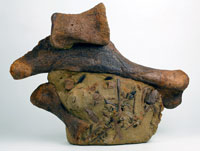 |
Large Block Of Duck Billed Dinosaur Bones. This huge 22 x 17.5 x 5 inch natural sandstone block contains many bones and teeth of the famous duckbilled dinosaur, Edmontosaurus annectens. Edmontosaurus was a favorite food choice for a T-Rex and lived in herds. This well preserved collage of bones from a single dinosaur resulted from the dinosaur being quickly buried under mud in a river or stream and remaining undisturbed for 66-67 million years until being found on a private ranch in the Lance Creek Formation of Niobrara County, Wyoming many years ago. The museum quality slab consists of a huge, near complete 22 inch long humerus arm bone and 7 inch long tarsal and 8 inch long metatarsal foot bones. In addition, there are over six gem quality teeth up to one inch long and many fragmented strut bones. The bone quality of the three main bones is outstanding, with just a few minor cracks filled on the humerus. The large humerus and tarsal bones have a complete 3D look being visible both front and back, just being connected to the matrix on their bottom sides. Most of the matrix has been expertly removed; the entire display is only 5 inches wide and stands on its own with a flat bottom. A display specimen from the famous George Lee fossil collection.
Add $70 for domestic shipping.
Estimated Value $2,750 - 3,500.
View details and enlarged photo
| Unsold |
Lot 1648 |
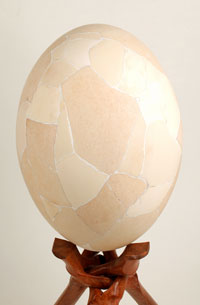 |
Largest Egg Known. The extinct flightless bird Aepyornis maximus produced the largest egg of any animal that ever lived, including dinosaurs. The egg in this lot is 13 inches high and 9 inches wide. This was the equivalent volume of 10-12 ostrich eggs or 160 chicken eggs. Aepyornis is commonly known as the elephant bird, a name that originated from Marco Polo's account of the giant bird in 1298. He described the ten foot tall Aepyornis that weighed over half a ton as having talons large enough to seize an elephant. Aepyornis was the largest bird that ever lived and only became extinct in the middle of the 17th century. Aepyornis only lived on the island of Madagascar and the shell from this bird that has been reconstructed to form this huge impressive egg is 10,000-20,000 years old and was found in the southern sands of Madagascar. Over 65% of the eggshell is from one egg. The color match is excellent as great care and time was spent in matching the sizes, curvature, and color of the needed egg fragments to put the egg back to its normal shape and size. The differences in color occur because of minerals penetrating the pores in the shell during the fossilization process. The egg is quite solid and stable. Elephant bird eggs are far rarer than Dinosaur eggs. There are only about a dozen unbroken Aepyornis eggs known, most in museums, with one selling at auction for over $30,000. This huge egg comes perched on a hand carved wooden stand for a very dramatic display.
Add $40 for domestic shipping.
Estimated Value $2,750 - 4,000.
View details and enlarged photo
| Realized
$1,740 |
Lot 1649 |
 |
Mammoth Tusk Diorama. A very large 30,000 year old, 23.5 inch long 6 inch wide outside section of dark Brown Mammoth tusk from Alaska was used to etch an artistic Alaska Diorama scene. A 13 x 5 inch section has been polished revealing light to medium beige colored ivory beneath. A diorama of Alaska was professionally etched and signed by artist B. Merry featuring two four-inch Mammoths, a male and a female greeting each other, perhaps to mate. There are mountain peaks in the distance along with trees and vegetation. This unique piece of art on a fossilized Mammoth tusk comes with a plastic stand for display.
Shipping: $35.
Estimated Value $2,000 - 3,000.
View details and enlarged photo
| Realized
$1,200 |
Lot 1650 |
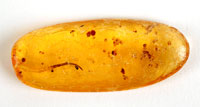 |
Lizard Tail In Madagascar Copal. Although insects are common in amber or copal, larger creatures such as lizards are rarely encountered because they are much bigger and can just walk away out of the gooey tree resin. Copal is just young amber that has not had the time to harden. This rare and spectacular .75 inch fossilized Lizard tail with four fossilized blood droplets is contained within 1.75 inch clear fully polished cabochon of two million year old Madagascar copal. This fossil tells a story of a small lizard being trapped in tree resin and then shedding his tail to free himself and in this act leaving four blood droplets which still remain fossilized in this extraordinary specimen. This lizard tail is beautifully preserved with excellent scales and brown color markings with bright red blood droplets. Both lizard and blood are extremely rare in copal or amber and complete small lizards have sold for more than $50,000 in amber. Presented in an 8 x 6 inch Riker mount.
Add $20 for domestic shipping.
Estimated Value $2,000 - 3,000.
View details and enlarged photo
| Unsold |
Lot 1651 |
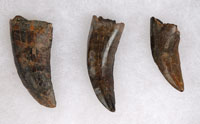 |
Three Juvenile T-Rex Teeth. These three complete juvenile T-Rex teeth are between 1.75 and 1.5 inches long and have excellent brown enamel with some minor enamel cracking, full tips except for some natural feeding wear, and even some serrations. Two inches is a large size for a juvenile T-Rex. All T-Rex teeth are shed teeth except the very few that are found with the dozen or so partial skeletons that have been found. These teeth were found in an ancient river or lake bed on a private ranch in the 65-67 million year old Hell Creek Formation of Powder River County, Montana. All of these teeth have squared-off bases at the bottom of the teeth, which is definitive for T-Rex teeth. There is still some debate as to whether the smaller, more slender teeth of the Juvenile T-Rex belong to T-Rex or are adult teeth of the smaller species Nano tyrannus. This is a difficult question to answer because they are found in the same age-rock formation. However, since there is only one complete skull of Nano tyrannus and only isolated teeth, claws and bones, these teeth probably are juvenile T-Rex teeth as there are many skeletons, mostly partial, of juvenile T-Rexes and the teeth do match those found in the juvenile T-Rex skull. Encased in a 6 x 5 inch
Ryker Mount.
Add $15 for domestic shipping.
Estimated Value $1,300 - 1,700.
View details and enlarged photo
| Unsold |
Lot 1652 |
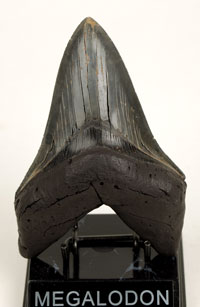 |
Megalodon Shark's Tooth. Carcharodon megalodon was the largest shark that ever lived, growing to more than 50 feet in length, and ate whales whose bones are found right alongside the huge teeth of megalodon. This immense, over-6-inch-on-the-diagonal, 15-20 million year old Carcharodon tooth was found in the muddy river waters of South Carolina. Estimating the length of a shark at about 10 feet in length to every one inch of tooth, this behemoth would be over 60 feet long. This huge tooth has lovely grey enamel with excellent very sharp serrations. The only restoration is some crack filling and smoothing that was professionally done on the black root of the huge tooth. The appearance is quite natural with the most important part of the tooth, its blade, being superb and original. The size of this tooth is very desirable, being over the magic 6 inches.
This spectacular tooth comes with a custom stand for display, identified as Megalodon.
Add $20 for domestic shipping.
Estimated Value $1,100 - 1,500.
View details and enlarged photo
| Realized
$1,200 |
Lot 1653 |
 |
Woolly Mammoth Tooth. Woolly Mammoths (Mammuthus primigenius) had the largest individual teeth of any animal that ever lived. Mammoths had six pairs of molars in both their upper and lower jaws during their lifetime. Each new molar would be larger than the preceding one and this large 9 inch long, 3.5 inches wide and 5.75 inches deep, well preserved molar was one of the molars of an adult Mammoth. The flat part of the tooth has attractive pearl and black enamel alternating with a dark brown dentine and a large 5 inch dark brown root that is virtually complete with very smooth surfaces. These Mammoth teeth come from the North Sea where they are dredged up in fishing nets and are between 30,000-75,000 years old. The quality of this complete tooth is far above average as most teeth recovered are broken or badly chipped. Comes with a plastic stand for display.
Add $30 for domestic shipping.
Estimated Value $1,000 - 1,400.
View details and enlarged photo
| Unsold |
Lot 1654 |
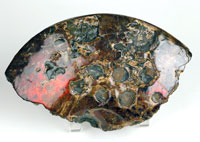 |
Rare Ammonite With Bite Marks. Ammonites were a squid-like animal that was covered with a shell containing inside growth chambers. They became extinct 66 million years ago at the same time as dinosaurs. Ammonites were the favorite prey for Mosasaurs who were the T-Rex of the ocean as they were the top predator. This extremely rare large 8.75 inch section of a Placentioceras sp. ammonite shows six superb distinct matching bite marks on both sides of the ammonite leaving no doubt about how this ammonite met its demise 75 million years ago in the warm shallow seas of South Dakota. The teeth marks are round and match exactly the round crocodile-like teeth that Mosasaurs possessed. In addition, the surface of the ammonite is covered with spectacular red and some green fossilized mother of pearl. This beautiful material has been designated as a gemstone with the name Ammolite. This extremely rare fossil with a story comes with a plastic display stand.
Add $20 for domestic shipping.
Estimated Value $1,000 - 1,500.
View details and enlarged photo
| Realized
$781 |
Lot 1655 |
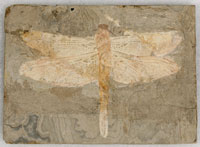 |
Dragonfly With Amazing Wing Detail. Solnhofen Germany is famous for its beautiful dragonfly fossils, but some even more spectacular fossil dragonflies come from the 140 million year old gray mudstone Liaoning Province of China. This rare species, Sinaeschinindia cancellosa, is one of the largest and most dramatic. Perfectly positioned on a 4.75 x 3.4 inch gray mudstone matrix, this large dragonfly has a 2.75 inch long body and a wingspan of 4 inches long. This is a complete beige dragonfly with a well defined head and amazing wing detail; even most of the delicate intricate white geometric wing patterns are preserved to make this dragonfly truly special.
Add $20 for domestic shipping.
Estimated Value $950 - 1,250.
View details and enlarged photos
| Realized
$1,050 |
Lot 1656 |
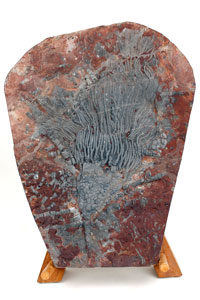 |
Huge Foot Long Crinoid. Crinoids, known as sea lilies, are relatives of starfish and, like starfish, have a five-fold symmetry. This huge, 10-inch-long, 6-inch-wide Calyx (the flower part of the crinoid) is unusual in that it is in its living position, having completely open branches which were used to filter-feed small organic particles and animals. The most minute details show in the individual arms, as well as a remarkable star-like pattern at the base of the Calyx. There is also a two-inch section of the stem that would have been much longer when the crinoid was alive and attached to the ocean bottom. This impressive crinoid, Scyphocrinites, is a dark gray color against a 13 x 10 inch dark brown matrix and is 375 million years old, from Morocco.
Add $25 for domestic shipping.
Estimated Value $850 - 1,150.
View details and enlarged photo
| Unsold |
Lot 1657 |
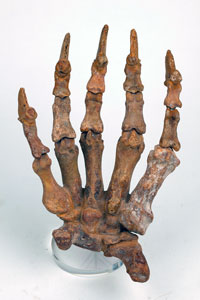 |
Case Bear Paw. Ursus spelaeus, the famous cave bear, was the largest bear that ever lived. It would have been nine to ten feet tall when standing on its hind legs. This complete paw is between 20,000-150,000 years old and was found in caves in Romania. The paw is 9 inches long and 5 inches wide, complete with all five digits and 1.5 inch claws. The claws would have been even larger and deadlier in life because they were covered with keratin, the same material as in our finger and toe nails. The paw is complete with a light brown color and has been mounted with wires for complete stability and display.
Add $20 for domestic shipping.
Estimated Value $750 - 900.
View details and enlarged photo
| Realized
$900 |
Lot 1658 |
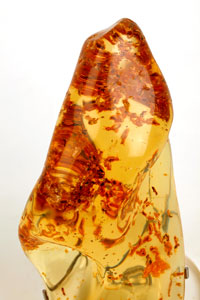 |
Large Colombian Amber Nugget Containing Termite Colony. Amber is the fossilized tree resin. Some trees produce resins to help heal breaks and gashes. Occasionally insects become trapped in the sticky amber and are mummified (dessicated) with incredible preservation of soft tissues, muscles, microscopic detail and sometimes even color. DNA has been retrieved from amber over 65 million years old at the time of the dinosaurs. The age of amber itself cannot be determined. Only the rock it is deposited in can be tested. Colombian amber is found mostly in the Andes mountains in remote regions and has not been properly dated. This amber with the classic golden honey color like Dominican Amber is probably between 1- 5 million years old. Such is the probable age of this extremely large, 7.25 x 3 x 2 inch, crystal-clear amber nugget, which weighs an enormous 327 grams. This excellent quality, clear amber nugget has been polished on all sides, revealing more than one hundred termites which can be viewed from any angle. This spectacular amber nugget comes with a five inch illusion stand for display.
Add $20 for domestic shipping.
Estimated Value $750 - 1,200.
View details and enlarged photo
| Realized
$1,031 |
Lot 1659 |
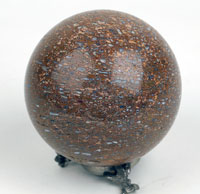 |
Agatized Dinosaur Bone Sphere. Agatized dinosaur bone occurs when the hollow bone structure of the dinosaur is replaced by quartz and trace minerals such as iron over millions of years. The best quality agatized dinosaur bone comes from the Jurassic era in Utah. 150 million year old Morrison Formation gem quality dinosaur bone was carefully shaped into a 4.25 inch sphere and polished, revealing a rainbow of colors in the individual cells, ranging from white, cream, brown, yellow, orange, and even green and blue. This gem-quality bone sphere is from the Tom Helfrich Collection. Tom Helfrich was the author of "Dinosaur Vanishing of a Gem Bone." This gem quality dinosaur bone sphere comes on its own custom iron stand for display.
Add $15 for domestic shipping.
Estimated Value $750 - 1,000.
View details and enlarged photo
| Realized
$780 |
Lot 1660 |
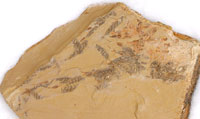 |
Important Offering Of The Very First Chordate Fossils. The 525 million year old fossils of Chengjiang are very important as being the earliest and best preserved of the early Cambrian fossils being 15 million years older than the famous Burgess Shale of Canada. Many types of small weird animals are found at Chengjiang, but perhaps the most important are the small group of fossils representing the earliest chordates which are the earliest ancestors of the vertebrates of which we are members. Haikouella is a chordate known from about 300 specimens. This small swimming animal was only about one inch long but had a head, gills, brain, notochord, heart and circulatory system and perhaps small eyes. This remarkable grouping of more than 20 animals in a mortality grouping is also important as it shows that Haikouella was a social animal living together in groups either for protection or perhaps as a group in hunting as they were predatory. Grouped together on a 5.5X3.5 inch slab, the gill slits which covered most of their body are very clear. Being soft bodied, any preservation is extraordinary. Finding a single fossil of Haikouella is rare, but such a grouping is a rare opportunity to study multiple specimens from the earliest site of the Cambrian explosion. This important grouping is housed in a 12 x 8 inch Riker mount for display.
Add $20 for domestic shipping.
Estimated Value $700 - 1,000.
View details and enlarged photo
| Unsold |
Lot 1661 |
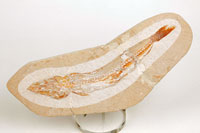 |
Amazing Fish Fossil With Another Fish In Its Stomach. This interesting 100 million year old, 9.5 inch long, salt water fish, Prionolepis from Lebanon, is complete with excellent detail on a 11 x 4 inch cream colored limestone slab. What makes it so special and rare is that within its stomach is its last meal, a 2 inch long fish that was swallowed whole and is still preserved intact with a clearly preserved head, bones, and its tail facing the head of the Prionolepis, which meant it was swallowed head first. This fascinating rare fossil has the orange brown fish nicely contrasted against the cream colored matrix.
Add $25 for domestic shipping.
Estimated Value $700 - 1,000.
View details and enlarged photo
| Realized
$906 |
Lot 1662 |
 |
Six Sauropod Teeth. Sauropods were the largest dinosaurs that ever lived, growing to over 100 feet long. These behemoths were plant-eating giants with small heads and extremely long necks. Rebbachisaurus was a 100 million year old, 70 foot long sauropod found in the Sahara desert of Africa. What distinguishes the titanosaur from the other sauropods is that it had tall spines on its back which may have supported a hump or sail. It was similar to some other titanosaurs from South America, offering support to the theory that South America and Africa were still joined together at this time.
These six peg-like teeth are 1.5-2 inches long, which is large for sauropods. These teeth were used only to rip vegetation from the branches of trees; they were not made for chewing as the greens were just swallowed whole. This collection is housed in a 8 x 12 inch Riker mount.
Add $20 for domestic shipping.
Estimated Value $650 - 850.
View details and enlarged photo
| Realized
$500 |
Lot 1663 |
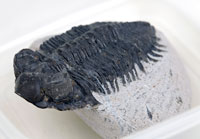 |
Three Different Trilobites. These three 375 million years old trilobites are from Alnif, Morocco and each has been professionally prepared to reveal every intricate detail. The spiny trilobite Omnia is 1.25 inches long on a 3 x 1.6 inch gray matrix. It is complete with three long spines, stalked eyes, and a bumpy ribose surface. The black two inch Drotops has been dramatically sculpted and raised on a 3 x 2 inch light gray matrix that shows the hypostome (mouth) underneath and good compound eye detail on one of the eyes The third trilobite, Coltrania, is 2.5 inches with extremely large raised compound eyes, with one of the eyes showing many faceted lenses. With such large eyes this trilobite probably lived at great depths where the lighting was limited.
Estimated Value $550 - 750.
View details and enlarged photos
| Realized
$348 |
Lot 1664 |
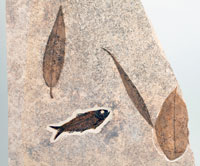 |
Green River Fish And Leaves. Green River Wyoming is famous for its exquisitely fossilized 50 million year old fish and leaves. These are usually found separately because most of the fish are found in deeper water than the plants, which are mostly found close to the ancient lake shore. Rarely are they found together as on this 14 x 11.5 inch limestone plate. This plate contains a perfectly preserved 4 inch long Knightia fish as well as three virtually complete leaves. There are two different species of leaves from a walnut tree, one being 6 x 1.25 inches and the other 5 x 2 inches. There also is a large 6 x .6 inch Willow leaf. All of the leaves have some vein definition as well as a little bit of the stem, and the Knightia has excellent fins as well as its complete skeleton. The medium to dark brown fossils are nicely contrasted against the cream colored limestone matrix.
Add $25 for domestic shipping.
Estimated Value $550 - 700.
View details and enlarged photo
| Realized
$432 |
Lot 1665 |
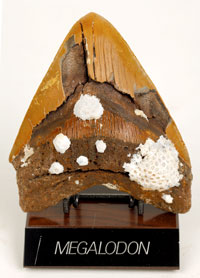 |
Megalodon Shark's Tooth with Coral. Even though Carcharodon megalodon was the largest shark that ever lived, growing to more than 50 feet in length, most of the teeth found are only 3-4 inches in length. Teeth over 5 inches in length are in great demand. This large 5.85 inches long, 4.5 inch wide, 15-20 million year old Carcharodon tooth was found in the muddy river waters of South Carolina. This huge tooth is completely natural as found and has an outstanding complete brownish-beige colored enamel on the flat side of the tooth. This was the side of the tooth facing outward in the shark's jaw. The curved inside of the tooth has a lot of missing enamel but is very unusual in having six white coral colonies, the largest colony being 1.5 x 1.5 inches growing on it. No restoration was done on the tooth and the coral colonies were left intact. Comes with a 7 x 5 inch custom wooden megalodon stand for display.
Add $20 for domestic shipping.
Estimated Value $450 - 650.
View details and enlarged photo
| Realized
$288 |
Lot 1666 |
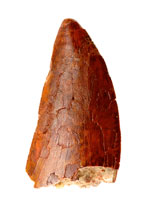 |
Carcharodontosaurus Dinosaur Tooth. Large 2.75 inches long (around the curve) by 1.50 inches wide complete dinosaur tooth of Carcharodontosaurus saharicus, the T-Rex of Africa. Even though Carcharodontosaurus was larger than a T-Rex, most of the teeth found are only 1.5 to 2.5 inches long. This complete reddish-brown shed tooth has very good enamel with only minor enamel chipping with almost always occurs. A lot of knife=like serrations are present on both edges of the tooth with only minor breaks. This large impressive tooth was found in the Sahara desert of Morocco. Carcharodontosaurus was older than a T-Rex at 70-80 million years old and is an excellent value for a huge carnivorous dinosaur tooth as a T-Rex tooth this size would cost more than $3,000.
Add $15 for domestic shipping.
Estimated Value $450 - 600.
View details and enlarged photo
| Realized
$288 |
Lot 1667 |
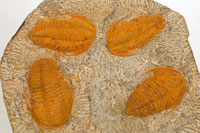 |
Four Trilobites On One Plate. Trilobites, early arthropods, were one of the most successful animals of all time, having survived for more than 250 million years, from 500 million years ago to the Permian extinction 250 million years ago. Trilobites were extinct for over 100 million years before the first dinosaurs appeared. This 500-million-year old, 11 x 9 inch plate contains four complete, excellently-detailed Paradoxite trilobites from Alnif, Morocco. They vary in size from 3 to 4 inches in length and are light brown in color, contrasted against a gray matrix.
Add $20 for domestic shipping.
Estimated Value $350 - 450.
View details and enlarged photo
| Realized
$432 |
Lot 1668 |
 |
Iridescent Scaphite Ammonite. Scaphites are a heteromorphic ammonite, which means that for some reason they started out forming the usual spiral shape of ammonites but then began to straighten out. This spectacular, complete, 75 million year old, 2.5 inch colorful ammonite is on a 4 x 3.75 inch matrix and comes from the Pierre Shales of South Dakota. This spectacular ammonite still has over 75% of its original mother of pearl that has iridescent pinks, greens and purples with the layer beneath the original outer shell being mostly iridescent green with hints of purple. Ammonites possessing such beautiful iridescent colors are now considered to be a gemstone known as ammonite. These spectacular colors are created by minerals being absorbed in the fossilization process.
Add $15 for domestic shipping.
Estimated Value $350 - 450.
View details and enlarged photo
| Unsold |
Lot 1669 |
 |
Fossilized Snake Egg. Fossilized snake eggs are much rarer than dinosaur eggs. This rare .9 inch beige egg is complete with 100% shell intact in a 2.25 x 2 inch matrix. This rare fossil snake egg known as Ophidienovum is 13 million years old from Mainz, Germany. The limestone matrix contains many small pieces of shell, proving that the egg was buried in water. Snakes first appeared in the fossil record around 98 million years ago. The exact species of snake cannot be determined and all snake fossils are rare in the fossil record. It is believed that the early primitive snakes dispatched their prey very much like modern constrictors such as a Python. Comes with a plastic stand for display.
Add $15 for domestic shipping.
Estimated Value $300 - 425.
View details and enlarged photo
| Unsold |
Lot 1670 |
 |
A Trio of Cretaceous Fossils. Consists of the following: Complete Crab fossil; Complete Shrimp fossil; Complete Trilobite fossil. Each approximately. 2½". A choice quality group of sea creatures.
Estimated Value $500 - 600.
View details and enlarged photo
| Realized
$288 |
Lot 1671 |
 |
A trio of visually attractive Fossils. Consists of the following: Ammonite in a polished split rock, where one half contains the shell and the other contains its crevice which fits together, Dia. 3½": Trilobite in full detail with its back embedded in rock, 5½"; Large adult trilobite in clam-like split rock matrix, dia. 8". Perfect items for display.
Estimated Value $300 - 400.
View details and enlarged photo
| Realized
$200 |
|
|